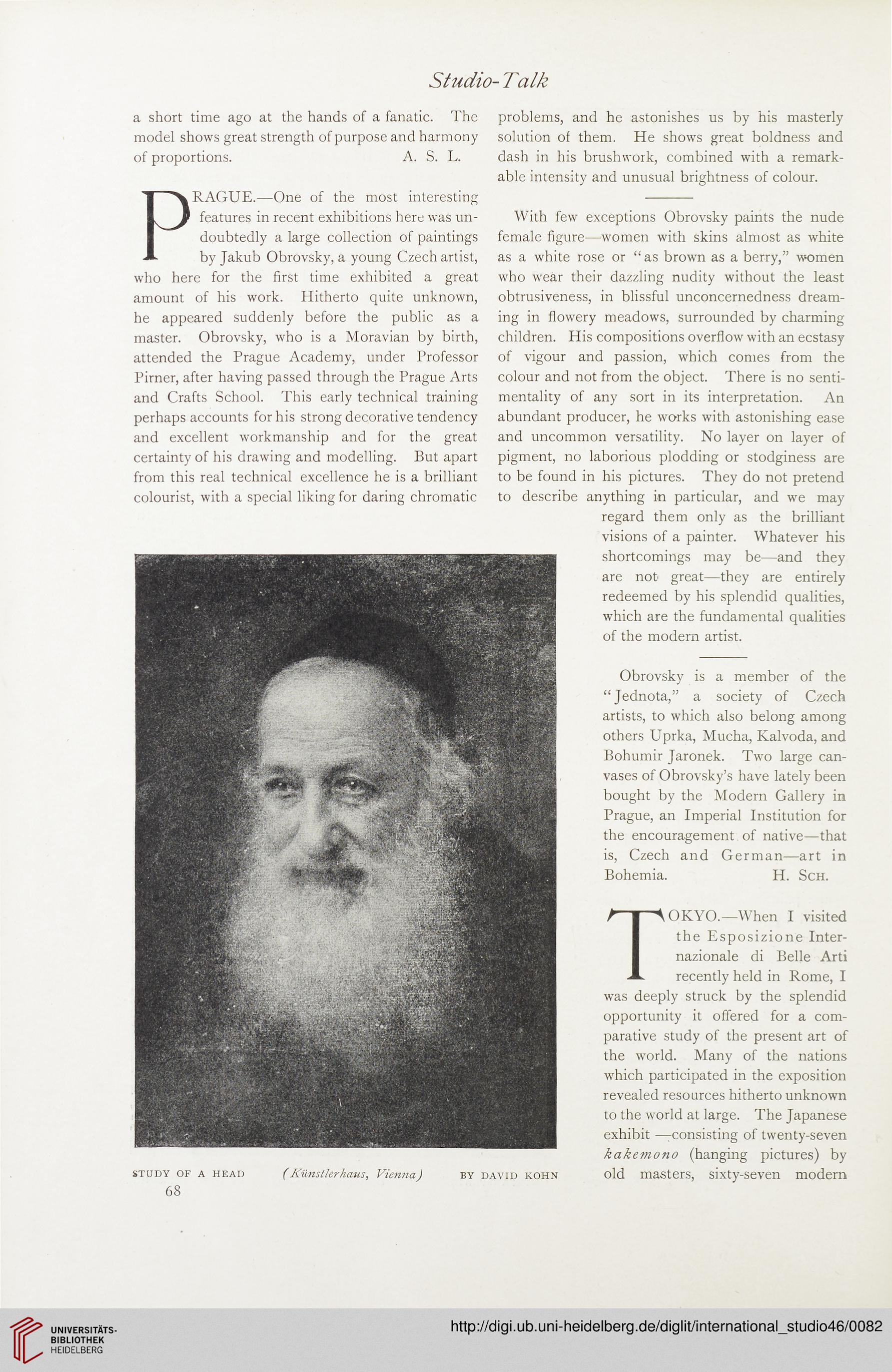Studio-Talk
a short time ago at the hands of a fanatic. The
model shows great strength of purpose and harmony
of proportions. A. S. L.
PRAGUE.—One of the most interesting
features in recent exhibitions here was un-
doubtedly a large collection of paintings
by Jakub Obrovsky, a young Czech artist,
who here for the first time exhibited a great
amount of his work. Hitherto quite unknown,
he appeared suddenly before the public as a
master. Obrovsky, who is a Moravian by birth,
attended the Prague Academy, under Professor
problems, and he astonishes us by his masterly
solution of them. He shows great boldness and
dash in his brushwork, combined with a remark-
able intensity and unusual brightness of colour.
With few exceptions Obrovsky paints the nude
female figure—women with skins almost as white
as a white rose or “as brown as a berry,” women
who wear their dazzling nudity without the least
obtrusiveness, in blissful unconcernedness dream-
ing in flowery meadows, surrounded by charming
children. His compositions overflow with an ecstasy
of vigour and passion, which conies from the
Pirner, after having passed through the Prague Arts
and Crafts School. This early technical training
colour and not from the object. There is no senti-
mentality of any sort in its interpretation. An
perhaps accounts for his strong decorative tendency
and excellent workmanship and for the great
certainty of his drawing and modelling. But apart
from this real technical excellence he is a brilliant
colourist, with a special liking for daring chromatic
abundant producer, he works with astonishing ease
and uncommon versatility. No layer on layer of
pigment, no laborious plodding or stodginess are
to be found in his pictures. They do not pretend
to describe anything in particular, and we may
( Kunstlerhaus, Vienna)
STUDY OF A HEAD
BY DAVID KOHN
regard them only as the brilliant
visions of a painter. Whatever his
shortcomings may be—and they
are nob great—they are entirely
redeemed by his splendid qualities,
which are the fundamental qualities
of the modern artist.
Obrovsky is a member of the
“Jednota,” a society of Czech
artists, to which also belong among
others Uprka, Mucha, Kalvoda, and
Bohumir Jaronek. Two large can-
vases of Obrovsky’s have lately been
bought by the Modern Gallery in
Prague, an Imperial Institution for
the encouragement of native—that
is, Czech and German—art in
Bohemia. H. Sch.
A ■ AOKYO.—When I visited
| the Esposizione Inter-
| nazionale di Belle Arti
A recently held in Rome, I
was deeply struck by the splendid
opportunity it offered for a com-
parative study of the present art of
the world. Many of the nations
which participated in the exposition
revealed resources hitherto unknown
to the world at large. The Japanese
exhibit —consisting of twenty-seven
kakemono (hanging pictures) by
old masters, sixty-seven modern
68
a short time ago at the hands of a fanatic. The
model shows great strength of purpose and harmony
of proportions. A. S. L.
PRAGUE.—One of the most interesting
features in recent exhibitions here was un-
doubtedly a large collection of paintings
by Jakub Obrovsky, a young Czech artist,
who here for the first time exhibited a great
amount of his work. Hitherto quite unknown,
he appeared suddenly before the public as a
master. Obrovsky, who is a Moravian by birth,
attended the Prague Academy, under Professor
problems, and he astonishes us by his masterly
solution of them. He shows great boldness and
dash in his brushwork, combined with a remark-
able intensity and unusual brightness of colour.
With few exceptions Obrovsky paints the nude
female figure—women with skins almost as white
as a white rose or “as brown as a berry,” women
who wear their dazzling nudity without the least
obtrusiveness, in blissful unconcernedness dream-
ing in flowery meadows, surrounded by charming
children. His compositions overflow with an ecstasy
of vigour and passion, which conies from the
Pirner, after having passed through the Prague Arts
and Crafts School. This early technical training
colour and not from the object. There is no senti-
mentality of any sort in its interpretation. An
perhaps accounts for his strong decorative tendency
and excellent workmanship and for the great
certainty of his drawing and modelling. But apart
from this real technical excellence he is a brilliant
colourist, with a special liking for daring chromatic
abundant producer, he works with astonishing ease
and uncommon versatility. No layer on layer of
pigment, no laborious plodding or stodginess are
to be found in his pictures. They do not pretend
to describe anything in particular, and we may
( Kunstlerhaus, Vienna)
STUDY OF A HEAD
BY DAVID KOHN
regard them only as the brilliant
visions of a painter. Whatever his
shortcomings may be—and they
are nob great—they are entirely
redeemed by his splendid qualities,
which are the fundamental qualities
of the modern artist.
Obrovsky is a member of the
“Jednota,” a society of Czech
artists, to which also belong among
others Uprka, Mucha, Kalvoda, and
Bohumir Jaronek. Two large can-
vases of Obrovsky’s have lately been
bought by the Modern Gallery in
Prague, an Imperial Institution for
the encouragement of native—that
is, Czech and German—art in
Bohemia. H. Sch.
A ■ AOKYO.—When I visited
| the Esposizione Inter-
| nazionale di Belle Arti
A recently held in Rome, I
was deeply struck by the splendid
opportunity it offered for a com-
parative study of the present art of
the world. Many of the nations
which participated in the exposition
revealed resources hitherto unknown
to the world at large. The Japanese
exhibit —consisting of twenty-seven
kakemono (hanging pictures) by
old masters, sixty-seven modern
68




